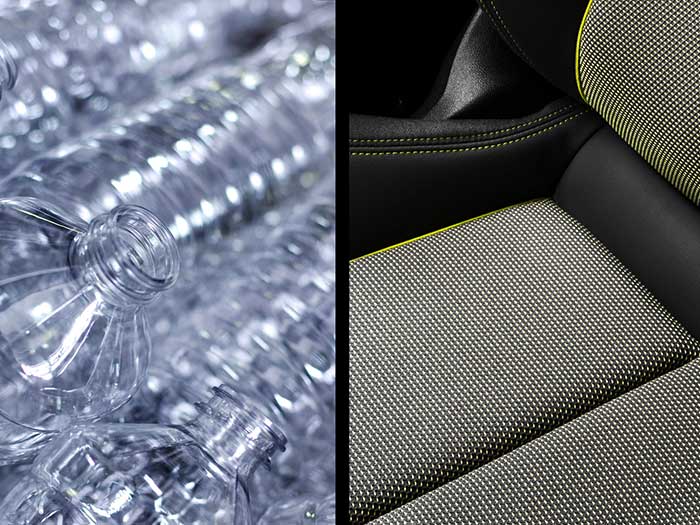Chemical recycling for automotive plastics: the Audi project
Audi has launched a pilot project across the whole supply chain. Its aim is the creation of smart circular systems to reuse the plastic materials of which many components in automobiles are made.
Plastic is a key material for the automotive sector, used to make many vehicle components which have to meet exacting safety, heat resistance and quality requirements.
That is why, so far, only petroleum-based materials have been suitable for manufacturing plastic components in automobiles that are subjected to particularly intensive wear. Such materials are not recyclable in most cases. And whereas plastics of the same type can be mechanically recycled, recycling of mixed plastic waste poses a major challenge. Audi and the Karlsruhe Institute for Technology (KIT) are therefore launching a pilot project for chemical recycling.
A circular system
The project is part of the “Industrial Resource Strategies” THINKTANK, whose objective is to feed such mixed plastic fractions back into a resource-conserving circular system. “We want to establish smart circular systems in our supply chains and make efficient use of resources,” says Marco Philippi, Senior Director of Procurement Strategy.
Chemical recycling has great potential: if plastic components can be produced from pyrolysis oil instead of petroleum, it would be possible to significantly increase the proportion of sustainably manufactured components in automobiles. “In the long run, this method can also play a role in end-of-life vehicle recycling,” adds Philippi.
A pilot project
The “Chemical Recycling of Plastics in Automotive Engineering” pilot project doesn’t just target the creation of smart circular systems for plastics – it also aims to establish this method as a complement to mechanical recycling and a replacement for energetic recovery.
Audi and KIT will evaluate the technical feasibility of chemical recycling as well as its economic and environmental impact at the Institute for Technical Chemistry (ITC) and the Institute for Industrial Production (IIP). Surplus components from returned Audi models – such as fuel tanks, wheel trim parts and radiator grills – will be used for this purpose.
Chemical recycling
Chemical recycling turns these plastic components into pyrolysis oil: an oil that is obtained from heating organic material without oxygen, thereby breaking down its chemical bonds. The quality of this oil is equal to that of petroleum products, and materials made from it are of the same high-grade quality as new ones.
Chemical recycling is so far the only method that can convert mixed plastic waste into high-quality new products, which means a wider range of plastics can be recovered. Such closed material loops conserve resources because less primary material is required. This, in turn, saves energy and costs – and also reduces CO2 emissions. Audi is one of the first automobile manufacturers to test this recycling method.
Pioneering work
“We are doing pioneering work here together with Audi,” says Professor Dieter Stapf, Head of the Institute for Technical Chemistry at KIT. The THINKTANK takes a holistic view of raw material loops – and chemical recycling could be a significant opportunity for the automotive industry.
“We are working with Audi to make automobiles more sustainable and environmentally friendly, irrespective of their type of powertrain, going forward” says Dr. Christian Kühne, the Managing Director of the THINKTANK.
Reducing emissions
Audi’s chemical recycling trial is part of its CO2 emission reduction program. The objective of the program is to use resources as efficiently as possible and to reduce CO2 emissions in the upstream value chain, focusing on materials that are either required in large quantities or entail particularly energy-intensive manufacturing processes.
A successful case in point is the Aluminum Closed Loop: Audi and its suppliers created this closed loop to recover aluminum waste and improve it to the point where its quality level is equivalent to a new product. In 2019 alone, this cut 150,000 metric tons of CO2 from the environmental balance sheet.
Secondary materials

Audi is planning to gradually increase the proportion of secondary materials in its models, as demonstrated by the use of PET for the new A3’s seat coverings. PET is a plastic polymer that can be easily separated from other materials and therefore recycled. For the Audi A3, three textile seat covers are available with a recycled material content of up to 89 percent.
“The challenge is the lower fabric, which is connected to the upper material with an adhesive. We are working on replacing this too with recyclable polyester, so that in the future the whole seat cover can be manufactured from the same type of material, so that it can be recycled” says Ute Grönheim, who is responsible for textile materials development at Audi. The long-term goal is to use recycled materials for textile seat covers across all model ranges, and once its technical feasibility can be demonstrated, industrialize the recycling technology and progressively apply it to more components.
Source: AUDI AG
